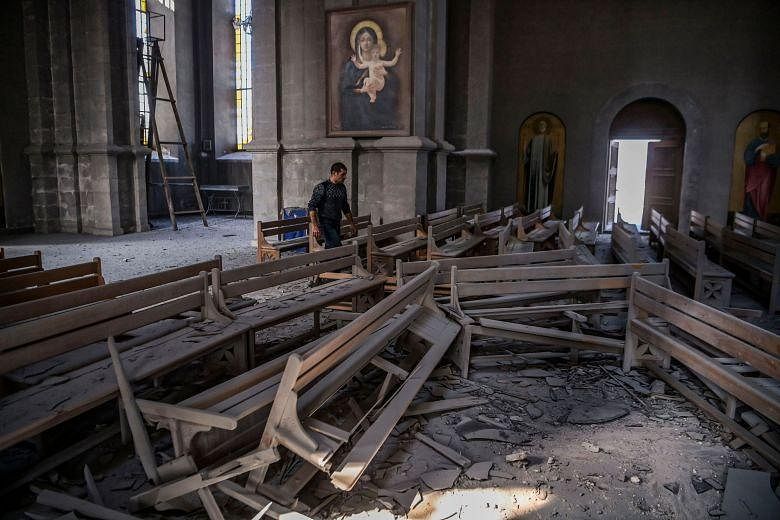SHUSHA, AZERBAIJAN (AFP) - Renewed shelling on a historic Armenian cathedral in the disputed Nagorno-Karabakh region has left several journalists injured, the Armenian government said on Thursday (Oct 8), after earlier strikes damaged the church.
"Russian and local journalists were wounded in the second shelling by Azerbaijani forces targeting Ghazanchetsots Cathedral," the Armenian government wrote on Twitter, adding that one of the reporters was undergoing surgery.
AFP journalists earlier onThursday witnessed extensive damage to the iconic Ghazanchetsots (Holy Saviour) Cathedral after shelling left its metal roof collapsed.
Azerbaijan denied the first round of shelling, saying its forces never target historical, cultural, or especially religious buildings and monuments.
The enormous cathedral, built between 1868 and 1887, is of major symbolic importance for Armenians.
It is the seat of the Diocese of Karabakh and suffered heavy damage during the 1990s war over the disputed region, when it was used as a storage site for Grad rockets by Azerbaijani forces.
Fighting between Armenian and Azerbaijani forces erupted again late last month over the disputed Karabakh region and the clashes have claimed more than 300 lives including civilians.
Both sides have accused the other of targeting civilian areas and the clashes show no sign of abating.
The shelling came ahead of the first meeting of international mediators seeking to halt escalating fighting over the disputed region.
Expectations for any major breakthrough from the talks in Geneva were low and no statements were expected from the negotiations being held behind closed doors and without Armenian participation.
Azerbaijan's Foreign Minister Jeyhun Bayramov was to meet diplomats from France, Russia and the United States, who make up the "Minsk Group" that has sought a solution to the Karabakh conflict since the 1990s.
Armenia's foreign minister will not be attending, after Yerevan ruled out talks between the two countries' top diplomats as long as clashes are ongoing. Zohrab Mnatsakanyan will instead meet his Russian counterpart in Moscow on Monday.
The fighting in one of the most lingering conflicts resulting from the fall of the Soviet Union erupted again on Sept 27, with Azerbaijan insisting the Nagorno-Karabakh region must return to its control.
Nagorno-Karabakh broke away from Azerbaijan in a war in the early 1990s that claimed the lives of some 30,000 people. The Armenian separatists declared independence.
The region's 140,000 inhabitants are now almost exclusively Armenians after the remaining Azerbaijanis left during the war.
However, the international community regards it as part of Azerbaijan and no state, including Armenia itself, recognises its independence.
Sporadic fighting has erupted frequently since a May 1994 ceasefire, most notably in 2016.
The current fighting is the worst since the 1994 ceasefire.
The clashes have displaced half of the population of the Nagorno-Karabakh region, according to its rights ombudsman.
"According to our preliminary estimates, some 50 per cent of Karabakh's population and 90 per cent of women and children - or some 70,000-75,000 people - have been displaced," Karabakh's rights ombudsman Artak Beglaryan told AFP on Wednesday.
Analysts say Turkey's involvement this time has changed the landscape.
Turkey has reportedly sent pro-Ankara Syrian fighters to boost Azerbaijan forces and also home-produced drones that have already been deployed with success in Libya and Syria.

